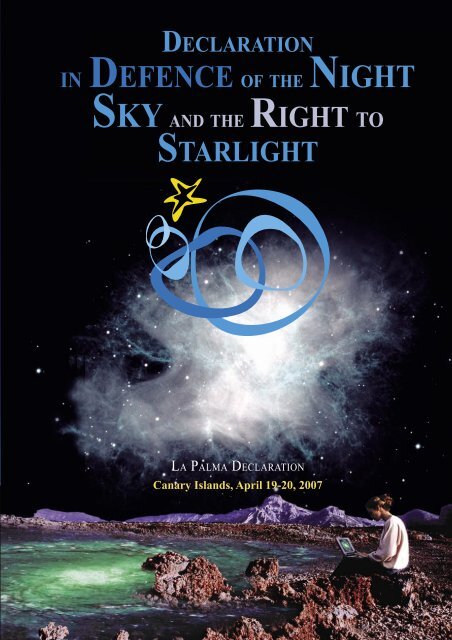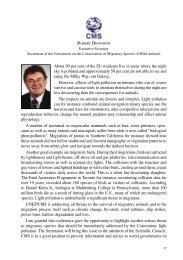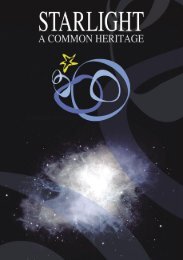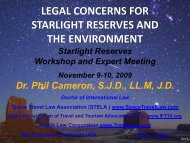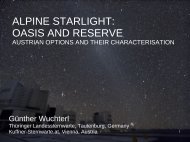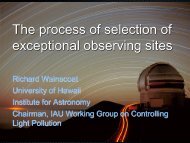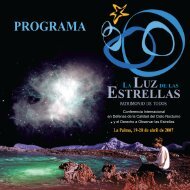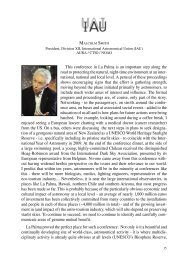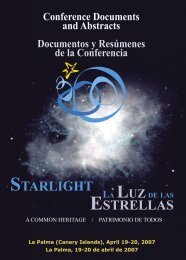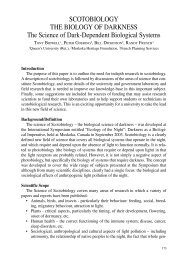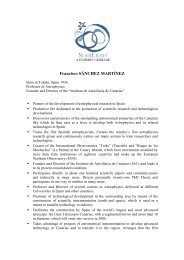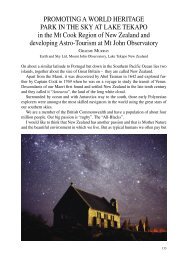IN DEFENCE OF THE - Starlight Initiative
IN DEFENCE OF THE - Starlight Initiative
IN DEFENCE OF THE - Starlight Initiative
Create successful ePaper yourself
Turn your PDF publications into a flip-book with our unique Google optimized e-Paper software.
DECLARATION<br />
<strong>IN</strong> <strong>DEFENCE</strong> <strong>OF</strong> <strong>THE</strong> NIGHT<br />
SKY AND <strong>THE</strong> RIGHT TO<br />
STARLIGHT<br />
LA PALMA DECLARATION<br />
Canary Islands, April 19-20, 2007
StarLight<br />
DECLARATION<br />
<strong>IN</strong> <strong>DEFENCE</strong> <strong>OF</strong> <strong>THE</strong> NIGHT SKY<br />
AND <strong>THE</strong> RIGHT TO STARLIGHT<br />
(La Palma Declaration)<br />
International Conference in Defence of the<br />
Quality of the Night Sky and the<br />
Right to Observe the Stars<br />
La Palma, Canary Islands, Spain - 2007
Photograph of the starry sky over La Palma taken on April 20 th , 2007, the night when the <strong>Starlight</strong> Declaration was adopted.<br />
© Bob Crelin<br />
Published by<br />
STARLIGHT <strong>IN</strong>ITIATIVE<br />
LA PALMA BIOSPHERE RESERVE / <strong>IN</strong>STITUTO DE ASTR<strong>OF</strong>ÍSICA DE CANARIAS /<br />
GOVERNMENT <strong>OF</strong> <strong>THE</strong> CANARY ISLANDS / SPANISH M<strong>IN</strong>ISTRY <strong>OF</strong> <strong>THE</strong> ENVIRONMENT / UNESCO - MaB.<br />
La Palma, Canary Islands, Spain, 2007.<br />
www. starlight2007.net<br />
Final revised version of the Declaration adopted at the <strong>Starlight</strong> 2007 Conference.<br />
Coordination:<br />
Cipriano Marín, Jafar Jafari.<br />
Revision:<br />
Giuseppe Orlando<br />
With the collaboration and suggestions of:<br />
Peter Bridgewater, Laura Calero Hernández, Phil Cameron, Miguel Clusener-Godt, Eduardo Fayos Solá, José María Garrido,<br />
Istvan Gyarmathy, Javier Gallego, Luis Gortázar Díaz-Llanos, Hiroji Isozaki, Ángel Landabaso, Luis Martínez,<br />
Juan Antonio Menéndez Pidal, Margarita Metaxa, Friedel Pas, Ferdinando Patat, Nigel Pollard, Rosa M. Ros, Antonio San Blas,<br />
Francisco Sánchez, Ramón San Martin, Anna Sidorenko-Dulom, Malcom Smith, Dirk Spennemann, Richard Wainscoat, David Welch,<br />
Arthouros Zervos.<br />
Design and Layout:<br />
Luis Mir<br />
Front cover photographs by<br />
IAC - Photograph by Luis Martínez - Composition by Gabriel Pérez.<br />
Back cover photograph:<br />
Miguel Briganti & Gabriel Pérez (IAC). Photographic composition taken from the Teide Observatory on Tenerife.<br />
Inside cover photograph:<br />
Javier Méndez (<strong>IN</strong>G) and Nik Szymanek. Image of M51 Galaxy taken with the William Herschel Telescope at the Roque de los<br />
Muchachos Observatory on La Palma.<br />
Translation: Gabinete Erasmus
STARLIGHT<br />
DECLARATION<br />
<strong>IN</strong> <strong>DEFENCE</strong> <strong>OF</strong> <strong>THE</strong> NIGHT SKY<br />
AND <strong>THE</strong> RIGHT TO STARLIGHT<br />
(LA PALMA DECLARATION)<br />
The participants in the International Conference in Defence of the Quality<br />
of the Night Sky and the Right to Observe the Stars, meeting in La Palma,<br />
Canary Islands, Spain, on the 19 th and 20 th of April 2007, jointly with the representatives<br />
of UNESCO, UNWTO, IAU, UNEP-CMS, COE, SCBD, MaB, EC<br />
and Ramsar Convention,<br />
Aware that a view of the starlight has been and is an inspiration for all<br />
humankind, that its observation has represented an essential element in the<br />
development of all cultures and civilizations, and that throughout history, the<br />
contemplation of the firmament has sustained many of the scientific and technical<br />
developments that define progress;<br />
Guided by the principles announced in the preamble of the Explanatory Note<br />
concerning the Proclamation of 2009 as International Year of Astronomy<br />
(33 rd session of the UNESCO General Conference) that defines the sky as a<br />
common and universal heritage and an integral part of the environment perceived<br />
by humankind;<br />
Recalling that humankind has always observed the sky either to interpret it or<br />
to understand the physical laws which govern the universe, and that the interest<br />
in astronomy has had profound implications for science, philosophy, culture,<br />
and our general conception of the universe;<br />
Recognizing that the quality of the night sky, and thus the capacity to access the<br />
light of stars and other celestial bodies within the universe, is deteriorating at an<br />
alarming rate in several areas, that its contemplation is increasingly difficult, and<br />
that this process faces mankind with the generalized loss of a cultural, scientific,<br />
and natural resource with unforeseeable consequences;<br />
1
STARLIGHT<br />
Conscious that the deterioration of the clarity of the night space has started<br />
to emerge as a serious barrier to the continuity of astronomic observations, a<br />
branch of science that presently provides a flow of direct and indirect benefits<br />
which are increasingly valued;<br />
Bearing in mind that the Rio Conference of 1992 proclaimed the necessary<br />
defence of the “integral and interdependent nature of the Earth”, and that this<br />
protection naturally includes the dimension of the night skies and the quality<br />
of the atmosphere;<br />
Acknowledging that the Universal Declaration of Human Rights of Future<br />
Generations states that persons belonging to future generations have the right<br />
to an uncontaminated and undamaged Earth, with untainted skies, and are entitled<br />
to enjoy these as the basis of human history of culture and social bonds<br />
making each generation and individual a member of one human family;<br />
Mindful of the validity of the Universal Declaration of Human Rights,<br />
adopted by the General Assembly of the United Nations, and of the different<br />
international declarations on sustainable development and the conventions and<br />
protocols concerning the environment — all these safeguarding cultural diversity,<br />
biological diversity, the landscape, and thus the conservation of cultural<br />
heritage and combating climate change, which together have a direct or indirect<br />
influence on the need to safeguard the clarity of the night skies;<br />
Considering that the scientific, cultural, educational, environmental, safety,<br />
and energy benefits of preserving a dark night sky need urgent attention and<br />
action;<br />
Attentive to the urgent need to establish efficient alliances among the leading<br />
players, whose decisions can have an influence on reversing the process of<br />
degradation affecting the quality of the night sky, with a view to providing all<br />
the possible assistance needed to protect and conserve the cultural and natural<br />
heritage of <strong>Starlight</strong>;<br />
2
STARLIGHT<br />
APPEAL to the International Community, and, in particular, URGE governments,<br />
other authorities and public institutions, decisionmakers, planners and<br />
professionals, private institutions and associations concerned, the world of science<br />
and of culture, and all citizens individually, to adopt the following principles<br />
and objectives of this declaration:<br />
1<br />
An unpolluted night sky that allows the enjoyment and contemplation of<br />
the firmament should be considered an inalienable right of humankind<br />
equivalent to all other environmental, social, and cultural rights, due to its impact<br />
on the development of all peoples and on the conservation of biodiversity.<br />
2<br />
The progressive degradation of the night sky must be considered an<br />
imminent risk that must be faced, in the same fashion that the main problems<br />
concerning resources and the environment are addressed.<br />
3<br />
The conservation, protection, and revaluation of the natural and cultural<br />
heritage associated with nocturnal landscapes and the observation of<br />
the firmament represents a prime opportunity and a universal obligation for<br />
cooperation in safeguarding the quality of life. For all decisionmakers, this attitude<br />
implies a genuine challenge involving cultural, technological, and scientific<br />
innovation, requiring a major constant effort to enable everyone to rediscover<br />
the presence of the night sky as a living part of the heritage of mankind.<br />
4<br />
Access to knowledge, armed with education, is the key to allow the integration<br />
of science into our present culture, contributing to the advance<br />
of humankind. The dissemination of astronomy and the scientific and cultural<br />
values associated with the contemplation of the universe should be considered<br />
as basic contents to be included in educational activities, which require a clear<br />
and unpolluted sky and proper training of educators in these subjects.<br />
5<br />
The negative effects of emissions and of the increased intrusion of artificial<br />
light on the atmospheric quality of nocturnal skies in protected areas<br />
have an impact on several species, habitats, and ecosystems. Control of obtrusive<br />
light must be a basic element of nature conservation policies and should be<br />
implemented in the management plans of the different types of protected areas<br />
to fulfil their mission in protecting nature and biological diversity.<br />
3
6<br />
STARLIGHT<br />
Mindful that a starry night sky forms an integral part of the landscape<br />
perceived by the inhabitants of every territory, including urban areas, the<br />
landscape policies established in the different juridical systems need to adopt<br />
the pertinent standards for preserving the quality of the night skyscape, thus<br />
allowing them to guarantee the common right to contemplate the firmament.<br />
7<br />
The intelligent use of artificial lighting that minimises sky glow and avoids<br />
obtrusive visual impact on both humans and wildlife has to be promoted.<br />
Public administrations, the lighting industry, and decisionmakers should also<br />
ensure that all users of artificial light do so responsibly as part of an integral part<br />
of planning and energy sustainability policies, which should be supported by<br />
light pollution measuring, both from the ground and from space. This strategy<br />
would involve a more efficient use of energy so as to meet the wider commitments<br />
made on climate change, and for the protection of the environment.<br />
8<br />
Areas suitable for unimpaired astronomic observation constitute an asset<br />
in short supply on our planet, and their conservation represents a minimum<br />
effort in comparison with the benefits they contribute to our know-how<br />
and to scientific and technological development. The protection of sky quality<br />
in these singular places must be given priority in regional, national, and international<br />
scientific and environmental policies. The measures and provisions must<br />
be made to safeguard clear skies and to protect such spaces from the harmful<br />
effects of light, radio-electric emissions, and air pollution.<br />
9<br />
Among others, tourism can become a major instrument for a new alliance<br />
in defence of the quality of the nocturnal skyscape. Responsible tourism<br />
can and should take on board the night sky as a resource to protect and value<br />
in all destinations. Generating new tourist products based on the observation<br />
of the firmament and the phenomena of the night, opens up unsuspected possibilities<br />
for cooperation among tourism stakeholders, local communities, and<br />
scientific institutions.<br />
10<br />
Sites included in the World Network of Biosphere Reserves, Ramsar<br />
Wetlands, World Heritage Sites, National Parks, and all those protected<br />
areas which combine exceptional landscape and natural values relying on the<br />
quality of their night sky, are called to include the protection of clear night skies<br />
as a key factor strengthening their mission in conserving nature.<br />
4
STARLIGHT<br />
All the necessary measures should be implemented to inform and to raise awareness<br />
among all the main actors involved in protecting the night environment<br />
—be it at local, national, regional, or international level— of the contents and<br />
the objectives of the International Conference in Defence of the Quality of the<br />
Night Sky and the Right to Observe the Stars, held on the Island of La Palma.<br />
5
STARLIGHT<br />
F<strong>IN</strong>AL RESOLUTIONS<br />
The International Conference in Defence of the Quality of the Night Sky and the Right to<br />
Observe the Stars considers it essential to make the following public appeals:<br />
1. In consonance with the principles announced in this Declaration, the Conference invites the<br />
authorities of States to take appropriate measures in order to safeguard the cultural and natural<br />
heritage of <strong>Starlight</strong>, and formulate action plans to provide effective protection of night sky,<br />
particularly in areas of interest for astronomic observation, protected areas that are sensitive to<br />
the loss of natural light from the night, and places of special importance related to astronomical<br />
heritage.<br />
2. The Conference agrees to refer the Declaration on the Defence of the Night Sky and the<br />
Right to <strong>Starlight</strong> to the Director-General of UNESCO for its acknowledgement and, if<br />
appropriate, recommendation to the Agencies and Bodies of the United Nations system as well<br />
as to the International Conventions related with the principles and objectives approached by the<br />
Declaration and other organizations directly involved, such as the International Astronomical<br />
Union (IAU).<br />
3. At the request of the Canary Island Government, once it has been adopted at a meeting of<br />
the Canary Islands Government Council in April 2007, the Conference decides to submit a<br />
proposal to UNESCO through the Spanish Government to declare April 20 st a World Right to<br />
Observe the Stars “Day”. The campaign will be launched under the name “The World Night”.<br />
4. The Conference proposes to the UNESCO-MaB Secretariat to present the final conclusions<br />
and achieved agreements at the 3 rd World Biosphere Reserves Congress, to be held in Madrid<br />
in 2008, with a view to include night sky protection, if appropriate, into the new Action Plan<br />
for Biosphere Reserves, acknowledging the important role that Biosphere Reserves can play as<br />
a network of true sustainable development laboratories.<br />
5. The Conference requests the five Conventions in the Biodiversity Liaison Group to<br />
examine the outcomes of its deliberations and, if appropriate, take to their governing bodies a<br />
combined view of the role of the conventions in helping increase protection for the night sky,<br />
understanding that this action will have positive effects on the conservation and wise use of<br />
biodiversity. The Conference also recommends to the World Conservation Union (IUCN) to<br />
examine this issue at its 4 th World Conservation Congress foreseen for Barcelona in late 2008.<br />
6. The Conference requests the UNESCO World Heritage Centre to inform the World Heritage<br />
Committee at its 31 st session to be held in Christchurch, New Zealand, 2007, on the development<br />
of an agreement within the framework of the UNESCO <strong>Initiative</strong> “Astronomy and World<br />
Heritage” and <strong>Initiative</strong> “<strong>Starlight</strong>”, with a view to define a concept of “<strong>Starlight</strong> Reserve” in<br />
order to nominate properties which can contribute by their exceptional night landscape to the<br />
astronomical researches worldwide.<br />
6
STARLIGHT<br />
ADDITIONAL RESOLUTION ON <strong>THE</strong> STEER<strong>IN</strong>G COMMITTEE<br />
AND <strong>THE</strong> SCIENTIFIC COMMITTEE.<br />
Having closed the Conference, and having adopted the “Declaration on the Defence of the<br />
Night Sky and the Right to <strong>Starlight</strong>”, in view of the importance of the agreements reached,<br />
provisions need to be made for the future. Continuity of the work and of the cooperation<br />
already achieved is of vital importance and, to consolidate the results achieved thus far, it is<br />
appropriate and necessary to follow up and implement the principles of the Declaration and<br />
the recommendations for the Action Plan.<br />
To this end, the following decisions are adopted:<br />
1. To create a Steering Committee to monitor the Declaration and its Action Plan (<strong>Starlight</strong><br />
<strong>Initiative</strong>), made up of the international agencies and institutions represented on the Conference<br />
Organization Committee, with the addition of representatives of UN World Tourism Organization,<br />
European Landscape Convention, International Astronomical Union, Ramsar Convention,<br />
UNEP Convention on Migratory Species, Secretariat of the Convention on Biological Diversity,<br />
Spanish National Commission for UNESCO, as well as of any initiatives and organizations related<br />
with the different subjects, competences, and disciplines that have an impact on the protection of<br />
the night sky that may be required, once the Committee has decided to do so.<br />
2. The <strong>Starlight</strong> <strong>Initiative</strong> Steering Committee shall ensure the dissemination, promotion, and<br />
circulation of the Declaration and its Action Plan, and its good implementation, following the<br />
recommendations of the Scientific Committee, and shall engage in all and any kind of activities<br />
that guarantee its continuity.<br />
3. The Steering Committee is charged with the dissemination and follow-up of the <strong>Starlight</strong><br />
Conference agreements; it shall take on the responsibility of presenting the Declaration to<br />
and disseminating it among the main stakeholders, including governments, local authorities,<br />
scientific institutions, dark sky initiatives, and agencies involved in environmental protection,<br />
defence of cultural diversity, and promotion of sustainable development.<br />
4. The Scientific Committee shall also propose drafting reports, conducting studies, campaigns,<br />
cooperation proposals, initiatives, and actions aimed at protecting the skies and enhancing their<br />
value, particularly contributing to the fulfilment of the objectives outlined in the Declaration.<br />
5. Among the specific initiatives arisen from the <strong>Starlight</strong> Conference, which will be approached<br />
by the works to be developed by the Scientific and Steering Committees, there are:<br />
• The establishment of a partnership with the Sustainable Energy Europe Campaign and<br />
development of a joint initiative, with the collaboration of European Renewable Energy<br />
Council, aiming to develop actions approaching night sky defence and its relation with the<br />
promotion of energy saving, the efficient use of energy, and renewable energies.<br />
7
STARLIGHT<br />
• Development of a cooperation agreement between the <strong>Starlight</strong> <strong>Initiative</strong> and the UNESCO<br />
World Heritage Centre through its thematic initiative “Astronomy and World Heritage”, that<br />
would also include the start of international consultations aimed to develop the “StarLight<br />
Reserves” concept.<br />
• To refer the Declaration to the European Parliament and the European Commission in<br />
order to disseminate its principles and, if appropriate, adopt them at the most pertinent<br />
level, mindful that clear sky defence is an important component of the fight against climate<br />
change.<br />
• To work jointly with the UN World Tourism Organization and Institute of Responsible<br />
Tourism (ITR) in order to promote awareness and knowledge related with night skyscape as<br />
a resource to put into value, supporting the development of new responsible destinations<br />
and tourist products based on star observation and night sky resources.<br />
• To strengthen cooperation and mutual support with the initiatives and organizations involved<br />
in dark sky conservation, particularly with International Dark Sky Association (IDA).<br />
• To work jointly with the European Landscape Convention to implement the new dimension<br />
of night landscape within the Convention, considering that landscape, including skycape, is<br />
a key factor in the physical, mental and spiritual well-being of individuals and societies.<br />
• To develop new ways of cooperation with organizations involved in culture promotion, in<br />
particular Unión Latina and the European Society for Astronomy in Culture (SEAC), to put<br />
into value the cultural heritage related with the observation of the firmament.<br />
• To work jointly with the International Commission on Illumination (CIE) in order to<br />
promote the intelligent use of lighting in all exterior applications. This to be with the aim<br />
of minimising both the use of energy and the spread of obtrusive light into the natural<br />
environment, particularly upwards into the sky.<br />
8
StarLight2007<br />
HONORARY BOARD<br />
ORGANIZ<strong>IN</strong>G COMMITTEE<br />
RAPPORTEURS<br />
SCIENTIFIC COMMITTEE<br />
ORGANIZATIONS
STARLIGHT<br />
HONORARY BOARD<br />
President:<br />
H.R.H. Felipe de Borbón<br />
Prince of Asturias<br />
Adán MARTÍN MENIS<br />
President of the Canary Islands Government<br />
Koïchiro MATSUURA<br />
Director-General of UNESCO<br />
Jose Luis PERESTELO RODRÍGUEZ<br />
President of La Palma Biosphere Reserve<br />
Cristina NARBONA RUÍZ<br />
Spanish Minister of Environment<br />
Mercedes CABRERA CALVO-SOTELO<br />
Spanish Minister of Education and Science<br />
Francisco SÁNCHEZ MARTÍNEZ<br />
Director - IAC (Instituto de Astrofísica de Canarias)<br />
10
STARLIGHT<br />
ORGANIZ<strong>IN</strong>G COMMITTEE<br />
Antonio SAN BLÁS<br />
Co-director of the <strong>Initiative</strong><br />
Manager - La Palma Biosphere Reserve<br />
Luis MARTÍNEZ<br />
Co-director of the <strong>Initiative</strong><br />
Head of Cabinet - IAC<br />
Juan GARAY ZABALA<br />
Director General<br />
Organismo Autónomo de Parques Nacionales<br />
Spanish Ministry of Environment<br />
Miguel Ángel PULIDO RODRÍGUEZ<br />
Director General - Planning and Landscape<br />
Canary Island Government<br />
Miguel CLÜSENER-GODT<br />
Division of Ecological Sciences<br />
MAB - UNESCO<br />
Cipriano MARÍN<br />
Coordinator of the <strong>Starlight</strong> <strong>Initiative</strong><br />
RAPPORTEURS<br />
Javier GALLEGO LORCA<br />
Universidad Politécnica de Valencia<br />
Ana VIÑA BRITO<br />
Scientific Committee of La Palma Biosphere Reserve<br />
Universidad de La Laguna<br />
Carlos FERNÁNDEZ HERNÁNDEZ<br />
Technical Committee of La Palma Biosphere Reserve<br />
Antonia VARELA PÉREZ<br />
IAC - Instituto de Astrofísica de Canarias<br />
Eulalia PÉREZ SEDEÑO<br />
Director General of FECYT (Spanish Foundation for Science and Technology)<br />
Felisa HODGSON<br />
CUC<br />
FranciscoLENO<br />
Plan de Excelencia Turística de Santoña<br />
General Rapporteur<br />
Luis GORTÁZAR DÍAZ-LLANOS<br />
GAIA<br />
Secretary-general of the Conference<br />
Juan Antonio MENÉNDEZ PIDAL<br />
Unión Latina<br />
11
STARLIGHT<br />
SCIENTIFIC COMMITTEE<br />
President<br />
Jafar JAFARI<br />
University of Wisconsin<br />
Tomás AZCÁRATE BANG<br />
President, Responsible Tourism Institute.<br />
Hiroji ISOZAKI<br />
Meiji Gakuin University.Japan<br />
Pedro BALLESTEROS TORRES<br />
Administrator of the Campaign<br />
“Sustainable Energy Europe”<br />
DG TREN - European Commission<br />
Marco BARBIERI<br />
Secretariat of the<br />
Convention on the Conservation<br />
of Migratory Species of Wild Animals<br />
Alexander BOKSENBERG<br />
President of the U.K. National Commission for<br />
UNESCO<br />
Professor of Experimental Astronomy at the University<br />
of Cambridge<br />
Peter BRIDGEWATER<br />
Secretary-general<br />
The Ramsar Convention on Wetlands<br />
Manuel CENDAGORTA<br />
Director<br />
ITER (Institute of Technology and Renewable Energy)<br />
David L.CRAWFORD<br />
Executive Director<br />
International Dark-Sky Association (IDA)<br />
Rafael DARANAS HERNÁNDEZ<br />
Scientific Committee<br />
La Palma Biosphere Reserve<br />
Maguelonne DÉJEANT-PONS<br />
Head of the Spatial Planning and Landscape Division<br />
Council of Europe<br />
Eduardo FAYOS SOLÁ<br />
Director<br />
Education and Knowledge Management<br />
UNWTO - World Tourism Organization<br />
Antonio FERNÁNDEZ RODRÍGUEZ<br />
Vice-rector for Research<br />
University of Las Palmas de Gran Canaria<br />
Manuel Nicolás FERNÁNDEZ RODRÍGUEZ<br />
Scientific Committee<br />
La Palma Biosphere Reserve<br />
Javier GALLEGO<br />
Former Director-general of UNWTO-Themis<br />
Foundation. University of Valencia<br />
Fernando HIRALDO<br />
CSIC (Higher Council for Scientific Resarch-Spain)<br />
Director of the Doñana Biological Station<br />
Natarajan ISHWARAN<br />
Director<br />
Division of Ecological and Earth Sciences UNESCO<br />
Wolf Michael IWAND<br />
TUI AG, Executive Director<br />
Group Corporate Environmental Management<br />
Lamine KADI<br />
Rector - University of Mostaganem Algeria<br />
Ángel LANDABASO<br />
DG - RTD<br />
European Commission<br />
Pierre LASSERRE<br />
Member of the Academia Europaea<br />
Pierre & Marie Curie University<br />
Gloria LÓPEZ MORALES<br />
President,<br />
Conservatorio Nacional del Patrimonio Cultural<br />
Juan Antonio MENÉNDEZ-PIDAL<br />
Director for Spain<br />
Unión Latina<br />
Nigel POLLARD<br />
Director: Division 5 (Exterior lighting)<br />
International Commission on Illumination (CIE)<br />
César PORTELA<br />
Architect<br />
Luis RAMALLO<br />
President of the Spanish National Commission for<br />
UNESCO<br />
Malcolm G. SMITH<br />
Director<br />
AURA Observatory in Chile<br />
President of IAU Division XII<br />
Francisco SÁNCHEZ<br />
Director - Instituto de Astrofísica de Canarias<br />
Antonio SERRANO RODRÍGUEZ<br />
Secretario General para el Territorio y la Biodiversidad<br />
Spanish Ministry of Environment<br />
Anna SIDORENKO-DULOM<br />
Coordinator of the Thematic <strong>Initiative</strong><br />
“Astronomy and World Heritage”<br />
UNESCO World Heritage Centre<br />
Arthouros ZERVOS<br />
President<br />
European Renewable Energy Council National<br />
Technical University of Athens<br />
Coordination:<br />
Cipriano MARÍN<br />
Coordinator of the <strong>Starlight</strong> <strong>Initiative</strong><br />
12
STARLIGHT<br />
ORGANIZATIONS, <strong>IN</strong>STITUTIONS and <strong>IN</strong>ITIATIVES<br />
which participated in the STARLIGHT CONFERENCE<br />
International Governmental Organizations:<br />
COUNCIL <strong>OF</strong> EUROPE (Spatial Planning and Landscape Division)<br />
CMS-UNEP (Convention on the Conservation of Migratory Species of Wild Animals)<br />
ESO (European Southern Observatory)<br />
European Commission - DG-TREN (Sustainable Energy Europe Campaign)<br />
IAU (International Astronomical Union)<br />
Ramsar Convention on Wetlands<br />
SCBD (Secretariat of the Convention on Biological Diversity)<br />
UNESCO (United Nations Educational, Scientific and Cultural Organization)<br />
Unión Latina<br />
UN-WTO (UN World Tourism Organization)<br />
International Non-governmental Organizations:<br />
CIE (International Commission on Illumination)<br />
EREC (European Renewable Energy Council)<br />
IDA (International Dark Sky Association)<br />
ITR (Responsible Tourism Institute)<br />
SEAC (European Society for Astronomy in Culture)<br />
Promoters - Organizers:<br />
Cabildo de La Palma<br />
Government of the Canary Islands<br />
IAC (Instituto de Astrofísica de Canarias)<br />
La Palma Biosphere Reserve<br />
MAB (UNESCO - Division of Ecological Scieces / Man and Biosphere Programme)<br />
Spanish Ministry of Environment<br />
<strong>IN</strong>TERNATIONAL DARK-SKY ASSOCIATION EUROPE<br />
OPTICON<br />
Optical Infrared Co-ordination Network<br />
for Astronomy<br />
ALGERIA<br />
UNIVERSITÉ DE MOSTAGANEM<br />
ARGENT<strong>IN</strong>A<br />
UNIVERSIDAD NACIONAL DE TUCUMÁN<br />
Departamento de Luminotecnia, Luz y Visión.<br />
ARMENIA<br />
BYURAKAN ASTROPHYSICAL OBSERVATORY<br />
AUSTRALIA<br />
CHARLES STURT UNIVERSITY<br />
SOUTH AUSTRALIAN SCHOOL <strong>OF</strong> ART<br />
University of South Australia<br />
AUSTRIA<br />
THÜR<strong>IN</strong>GER LANDESSTERNWARTE TAUTENBURG<br />
KUFFNER-STERNWARTE, IDA AUSTRIA<br />
BELGIUM<br />
MERCATOR TELESCOPE<br />
PREVENTIE LICHTH<strong>IN</strong>DER VZW<br />
VERENIG<strong>IN</strong>G VOOR STERRENKUNDE VZW WERKGROEP<br />
LICHTH<strong>IN</strong>DER<br />
CANADA<br />
ASTROLAB DU MONT-MÉGANTIC<br />
MEMO Environnement.<br />
MUSKOKA HERITAGE FOUNDATION<br />
PARKS CANADA<br />
QUEEN’S UNIVERSITY<br />
ROYAL ASTRONOMICAL SOCIETY <strong>OF</strong> CANADA.<br />
UNIVERSITÉ DE SHERBROOKE<br />
Groupe de recherche et d’applications en physique - Centre<br />
d’application et de recherche en télédetection.<br />
CHILE<br />
OPPC- Oficina de Protección de la Calidad del Cielo del Norte de Chile.<br />
PONTIFICIA UNIVERSIDAD CATÓLICA DE VALPARAÍSO<br />
CERRO TOLOLO <strong>IN</strong>TER-AMERICAN OBSERVATORY<br />
FRANCE<br />
CAP ASTRO<br />
CERN<br />
GREECE<br />
PHILEKPAIDEUTIKI ETAIREIA<br />
RENES-NTUA<br />
National Technical University of Athens.<br />
13
STARLIGHT<br />
NATIONAL AND KAPODISTRIAN UNIVERSITY <strong>OF</strong><br />
A<strong>THE</strong>NS. Department of Astrophysics, Astronomy and Mechanics<br />
GERMANY<br />
MAX PLANCK <strong>IN</strong>STITUT FÜR ASTRONOMIE, Heidelberg.<br />
MUSEUM AM SCHÖLERBERG<br />
Natur und Umwelt - Planetarium<br />
TUI-AG. Group Corporate Environmental Management.<br />
WORK<strong>IN</strong>G GROUP DARK SKY <strong>OF</strong> <strong>THE</strong> GERMAN<br />
AMATEUR ASTRONOMICAL SOCIETY.<br />
HUNGARY<br />
DUNA-DRÁVA NATIONAL PARK DIRECTORATE<br />
HORTOBÁGY NATIONAL PARK DIRECTORATE<br />
KONKOLY OBSERVATORY<br />
ISRAEL<br />
BAR-ILAN UNIVERSITY. Mathematics Department.<br />
ITALY<br />
ISTITUTO DI SCIENZA E TECNOLOGIA<br />
DELL’<strong>IN</strong>QU<strong>IN</strong>AMENTO LUM<strong>IN</strong>OSO<br />
JAPAN<br />
MEIJI GAKU<strong>IN</strong> UNIVERSITY<br />
NEW ZEALAND<br />
EARTH AND SKY LTD. Lake Tekapo.<br />
UNIVERSITY <strong>OF</strong> CANTERBURY. Dept. of Physics and<br />
Astronomy<br />
POLAND<br />
BIALOWIEZA NATIONAL PARK. Research Unit.<br />
SAUDI ARABIA<br />
K<strong>IN</strong>G ABDULAZIZ CITY FOR SCIENCE TECHNOLOGY.<br />
Astronomy and Geophysics Research. Institute. Space Research<br />
Institute.<br />
K<strong>IN</strong>G SAUD UNIVERSITY<br />
Faculty of Science, Physics and Astronomy Department.<br />
SPA<strong>IN</strong><br />
AAC Centro de Acústica Aplicada S.L.<br />
AAP - La Palma Astronomical Amateur Association.<br />
AYUNTAMIENTO DE ADEJE. Environment Department.<br />
AYUNTAMIENTO DE ALICANTE<br />
AYUNTAMIENTO DE SANTA CRUZ DE LA PALMA<br />
AYUNTAMIENTO DE BREÑA BAJA<br />
AYUNTAMIENTO DE LOS LLANOS DE ARIDANE<br />
AYUNTAMIENTO DE GARAFÍA<br />
AYUNTAMIENTO DE SAN ANDRÉS Y SAUCES<br />
ASTROPALMA GROUP<br />
CÁMARA DE COMERCIO DE LA PALMA<br />
CELFOSC. Associació contra la Contaminació Lumínica. Catalonia.<br />
COLEGIO DE <strong>IN</strong>GENIEROS <strong>IN</strong>DUSTRIALES DE SANTA<br />
CRUZ DE TENERIFE<br />
CSIC. Astrophysical Institute of Andalusia.<br />
DOÑANA BIOSPHERE RESERVE<br />
EL HIERRO BIOSPHERE RESERVE<br />
FECYT. Spanish Foundation for Science and Technology.<br />
FUNDACION GALILEI <strong>IN</strong>AF<br />
GOAT - Group of Astronomical Observers of Tenerife.<br />
GRAN CANARIA BIOSPHERE RESERVE<br />
ISAAC NEWTON GROUP <strong>OF</strong> TELESCOPES<br />
<strong>IN</strong>DAL<br />
ISLA BONITA RURAL TOURISM ASSOCIATION<br />
ITER - Institute of Technology and Renewable Energy.<br />
IRUENE LA PALMA - Archaeoastronomy Group.<br />
ISONORTE EMPLEO. La Palma.<br />
LABORATORIO DEL PAISAJE DE CANARIAS.<br />
LANZAROTE BIOSPHERE RESEVE<br />
M<strong>IN</strong>ORCA BIOSPHERE RESERVE<br />
NATURA CONSULTORÍA Y GESTIÓN S.L.<br />
OTPC-IAC - Oficina Técnica para la Protección de la Calidad del<br />
Cielo. Islas Canarias.<br />
ORM - Roque de los Muchachos Observatory.<br />
POLYTECHNIC UNIVERSITY <strong>OF</strong> VALENCIA<br />
PATRONATO DE TURISMO DE LA PALMA<br />
REVISTA ASTRONOMÍA<br />
REVISTA CAOS Y CIENCIA<br />
SIERRA NEVADA BIOSPHERE RESERVE<br />
SPANISH NATIONAL COMMISSION FOR UNESCO<br />
SPANISH ASTRONOMICAL SOCIETY<br />
TECHNICAL UNIVERSITY <strong>OF</strong> CATALONIA<br />
TYPMA<br />
UNESCO CENTRE <strong>OF</strong> <strong>THE</strong> CANARY ISLANDS<br />
UNIVERSITY <strong>OF</strong> LA LAGUNA<br />
UNIVERSITY <strong>OF</strong> LAS PALMAS DE GRAN CANARIA<br />
UNIVERSIDAD COMPLUTENSE DE MADRID<br />
ASAAF. Dep de Astrofísica y CC. de la Atmósfera.<br />
URDAIBAI BIOSPHERE RESERVE<br />
SWITZERLAND<br />
FEDERAL <strong>OF</strong>FICE <strong>OF</strong> <strong>THE</strong> ENVIRONMENT<br />
TUNISIA<br />
CITÉ DES SCIENCES - UNAWE PROJECT<br />
UNITED K<strong>IN</strong>GDOM<br />
BRITISH ASTRONOMICAL ASSOCIATION<br />
CAMPAIGN FOR DARK SKIES<br />
DEMONTFORT UNIVERSITY - School of Law.<br />
NEP Lighting Consultancy.<br />
USA<br />
ANNALS <strong>OF</strong> TOURISM RESEARCH<br />
AURA/NOAO<br />
CALIFORNIA <strong>IN</strong>STITUTE <strong>OF</strong> TECHNOLOGY<br />
Palomar Observatory<br />
CREL<strong>IN</strong> CREATIVE - The GlareBuster.<br />
HARVARD UNIVERSITY<br />
STELA - Space Travel Law Association.<br />
<strong>THE</strong> URBAN WILDLANDS GROUP<br />
UCLA - Department of Geography, Institute of the Environment,<br />
Department of Ecology and Evolutionary Biology.<br />
UNIVERSITY <strong>OF</strong> CONNECTICUT.<br />
Department of Physics.<br />
UNIVERSITY <strong>OF</strong> HAWAII. Institute for Astronomy.<br />
UNIVERSITY <strong>OF</strong> WISCONS<strong>IN</strong><br />
US NATIONAL PARK SERVICE<br />
Night Sky Team<br />
US NAVAL OBSERVATORY<br />
UTICA COLLEGE. Department of Biology.<br />
14
www.starlight2007.net
Organisers:<br />
La Palma<br />
Biosphere Reserve<br />
Instituto de<br />
Astrofísica de Canarias<br />
Gobierno de Canarias<br />
Cabildo de La Palma<br />
International Conference in Defence of the Quality of<br />
the Night Sky and the Right to Observe the Stars<br />
StarLight 2007


